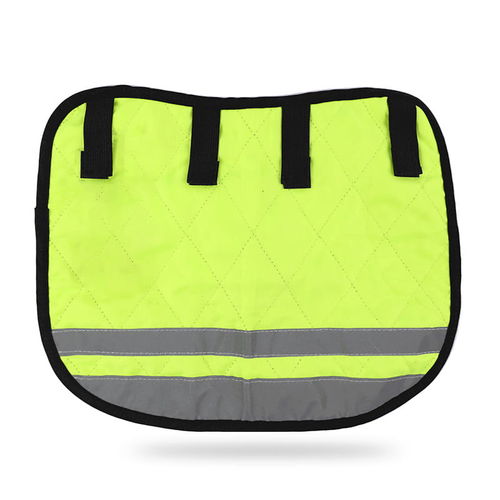The hard hat is one of the most recognizable and critical pieces of Personal Protective Equipment (PPE) on any construction site or industrial floor. While the rigid outer shell provides indispensable protection against impacts and falling objects, the often-overlooked components that interact directly with the wearer—specifically Hard Hat Pads—play a crucial role in promoting compliance, comfort, and preventing heat-related stress. Moving past the basic safety mandate, the use of specialized pads transforms a mandatory piece of gear into a tool that actively enhances a worker’s focus and well-being.
The Dual Purpose of Hard Hat Pads: Comfort and Sweat Management
The primary challenge of mandatory PPE is ensuring workers wear it correctly for the entire duration of their shift. A common complaint is discomfort, particularly in environments with high heat or intense physical activity. This is where Hard Hat Pads become a vital accessory, serving two major functions:
- Enhanced Comfort and Fit: Standard hard hat suspensions, while engineered for impact dispersion, can create pressure points on the head. Pads provide an essential layer of cushioning, distributing the helmet’s weight more evenly across the head. This significantly reduces pressure, chafing, and the likelihood of workers attempting to adjust the fit by loosening the suspension, which would compromise its protective function.
- Superior Sweat Absorption: In hot and humid conditions, perspiration is inevitable. Sweatbands and hard hat pads are specifically designed with absorbent or moisture-wicking materials (like terry cloth, microfiber, or specialized synthetic polymers) to capture sweat before it runs into the eyes, impairing vision and causing a stinging sensation. Effective sweat management is a direct contributor to maintained focus and, therefore, workplace safety.
Specialized Types of Hard Hat Pads for Environmental Control
The evolution of PPE has introduced highly specialized Hard Hat Pads to address specific environmental hazards beyond simple impact.
- Evaporative Cooling Pads: These accessories are essential for mitigating the risk of heat stress, a significant concern in summer months or high-heat industrial settings. Typically made from a polymer-based fabric (such as PVA), these pads are soaked in water to activate powerful cooling crystals. They attach to the suspension and release a cooling sensation through evaporation, helping to regulate the wearer’s core temperature for several hours.
- Moisture-Wicking and Anti-Odor Pads: For continuous use, pads made from performance-grade synthetic materials actively pull moisture away from the skin and promote rapid drying. Many of these are also treated with anti-microbial agents, which is critical for maintaining hygiene and preventing the buildup of bacteria and odors within the helmet—a key factor in encouraging consistent daily wear.
- Padded Liners: Distinct from sweatbands, full liners can provide cushioning around the crown of the head or at the ratchet adjustment point (ratchet pads). This ensures stability and padding at crucial contact areas, which is particularly beneficial for Type II hard hats that include a foam inner layer for lateral impact protection.
Safety Compliance and Pad Integration
While Hard Hat Pads offer substantial comfort benefits, it is paramount that their use does not compromise the certified safety rating of the hard hat itself. Safety guidelines, such as those set by ANSI/ISEA Z89.1, govern how hard hats must be worn and maintained.
- Avoiding Unauthorized Modifications: Workers should only use pads or liners specifically approved by the hard hat manufacturer or a reputable accessory brand. Non-compliant additions that create a gap between the shell and the suspension, or those that compress the suspension system, can void the safety rating of the hard hat and its ability to properly absorb and distribute impact force.
- Material Compatibility: In environments with electrical hazards, any added accessory must not be made of conductive materials. Similarly, for fire or welding applications, Hard Hat Pads must be made from flame-resistant (FR) or self-extinguishing materials to ensure they do not become a secondary hazard.
- Ease of Maintenance: For maximum hygiene and longevity, modern pads are typically designed to be removable and machine-washable. Regular replacement, often recommended every few months depending on usage, prevents degradation and ensures the protective shell and suspension system remain clean and in good working order.
In conclusion, the decision to use high-quality Hard Hat Pads is an investment in human capital. By tackling the issues of discomfort, sweat, and heat, these simple accessories directly influence a worker’s comfort, hygiene, and most importantly, their compliance with critical safety requirements, ultimately fostering a safer and more productive work environment.

 English
English 简体中文
简体中文








 3rd Floor, East Gate, No. 2599 Park Road, Sheng Ze Town, Wu Jiang District, Suzhou City, Jiangsu Province
3rd Floor, East Gate, No. 2599 Park Road, Sheng Ze Town, Wu Jiang District, Suzhou City, Jiangsu Province  +86- 0512-63519080
+86- 0512-63519080
 +86-13584404311
+86-13584404311  FQsales1@163.com
FQsales1@163.com